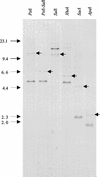Role of two novel two-component regulatory systems in development and phosphatase expression in Myxococcus xanthus
- PMID: 12562808
- PMCID: PMC142856
- DOI: 10.1128/JB.185.4.1376-1383.2003
Role of two novel two-component regulatory systems in development and phosphatase expression in Myxococcus xanthus
Abstract
We have cloned a two-component regulatory system (phoR2-phoP2) of Myxococcus xanthus while searching for genes that encode proteins with phosphatase activity, where phoR2 encodes the histidine kinase and phoP2 encodes the response regulator. A second system, phoR3-phoP3, was identified and isolated by using phoP2 as a probe. These two systems are quite similar, sharing identities along the full-length proteins of 52% on the histidine kinases and 64% on the response regulators. The predicted structures of both kinases suggest that they are anchored to the membrane, with the sensor domains being located in the periplasmic space and the kinase domains in the cytoplasm. The response regulators (PhoP2 and PhoP3) exhibit a helix-loop-helix motif typical of DNA-binding proteins in the effector domains located in the C-terminal region. Studies on two single-deletion mutants and one double-deletion mutant have revealed that these systems are involved in development. Mutant fruiting bodies are not well packed, originating loose and flat aggregates where some myxospores do not reshape properly, and they remain as elongated cells. These systems are also involved in the expression of Mg-independent acid and neutral phosphatases, which are expressed during development. The neutral phosphatase gene is especially dependent on PhoP3. Neither PhoP2 nor PhoP3 regulates the expression of alkaline phosphatases and the pph1 gene.
Figures


 , amino acids that constitute the two helixes of the helix-loop-helix motif.
, amino acids that constitute the two helixes of the helix-loop-helix motif.


Similar articles
-
phoR1, a gene encoding a new histidine protein kinase Myxococcus xanthus.Antonie Van Leeuwenhoek. 2003;83(4):361-8. doi: 10.1023/a:1023360116904. Antonie Van Leeuwenhoek. 2003. PMID: 12777072
-
TodK, a putative histidine protein kinase, regulates timing of fruiting body morphogenesis in Myxococcus xanthus.J Bacteriol. 2003 Sep;185(18):5452-64. doi: 10.1128/JB.185.18.5452-5464.2003. J Bacteriol. 2003. PMID: 12949097 Free PMC article.
-
Myxococcus xanthus sasS encodes a sensor histidine kinase required for early developmental gene expression.J Bacteriol. 1997 Dec;179(24):7759-67. doi: 10.1128/jb.179.24.7759-7767.1997. J Bacteriol. 1997. PMID: 9401035 Free PMC article.
-
Dual regulation with Ser/Thr kinase cascade and a His/Asp TCS in Myxococcus xanthus.Adv Exp Med Biol. 2008;631:111-21. doi: 10.1007/978-0-387-78885-2_7. Adv Exp Med Biol. 2008. PMID: 18792684 Review.
-
How important is the phosphatase activity of sensor kinases?Curr Opin Microbiol. 2010 Apr;13(2):168-76. doi: 10.1016/j.mib.2010.01.013. Epub 2010 Mar 10. Curr Opin Microbiol. 2010. PMID: 20223700 Free PMC article. Review.
Cited by
-
Myxococcus xanthus Pph2 is a manganese-dependent protein phosphatase involved in energy metabolism.J Biol Chem. 2009 Oct 16;284(42):28720-8. doi: 10.1074/jbc.M109.015248. Epub 2009 Aug 25. J Biol Chem. 2009. PMID: 19706604 Free PMC article.
-
PhoR1-PhoP1, a third two-component system of the family PhoRP from Myxococcus xanthus: role in development.J Bacteriol. 2005 Jul;187(14):4976-83. doi: 10.1128/JB.187.14.4976-4983.2005. J Bacteriol. 2005. PMID: 15995213 Free PMC article.
-
Differential expression of the three multicopper oxidases from Myxococcus xanthus.J Bacteriol. 2007 Jul;189(13):4887-98. doi: 10.1128/JB.00309-07. Epub 2007 May 4. J Bacteriol. 2007. PMID: 17483223 Free PMC article.
-
Transcriptome dynamics of the Myxococcus xanthus multicellular developmental program.Elife. 2019 Oct 14;8:e50374. doi: 10.7554/eLife.50374. Elife. 2019. PMID: 31609203 Free PMC article.
-
Phosphate acquisition components of the Myxococcus xanthus Pho regulon are regulated by both phosphate availability and development.J Bacteriol. 2008 Mar;190(6):1997-2003. doi: 10.1128/JB.01781-07. Epub 2008 Jan 4. J Bacteriol. 2008. PMID: 18178740 Free PMC article.
References
-
- Avery, L., and D. Kaiser. 1983. In situ transposon replacement and isolation of a spontaneous tandem duplication. Mol. Gen. Genet. 19:99-109. - PubMed
-
- Bilwes, A. M., L. A. Alex, B. R. Crane, and M. I. Simon. 1999. Structure of CheA, a signal-transducing histidine kinase. Cell 96:131-141. - PubMed
-
- Capela, D., F. Barloy-Hubler, J. Gouzy, G. Bothe, F. Ampe, J. Batut, P. Boistard, A. Becker, M. Boutry, E. Cadieu, S. Dreano, S. Gloux, T. Godrie, A. Goffeau, D. Kahn, E. Kiss, V. Lelaure, D. Masuy, T. Pohl, D. Portetelle, A. Puehler, B. Purnelle, U. Ramsperger, C. Renard, P. Thebault, M. Vandenbol, S. Weidner, and F. Galibert. 2001. Analysis of the chromosome sequence of the legume symbiont Sinorhizobium meliloti strain 1021. Proc. Natl. Acad. Sci. USA 98:9877-9882. - PMC - PubMed
Publication types
MeSH terms
Substances
Associated data
- Actions
- Actions
LinkOut - more resources
Full Text Sources
Miscellaneous

